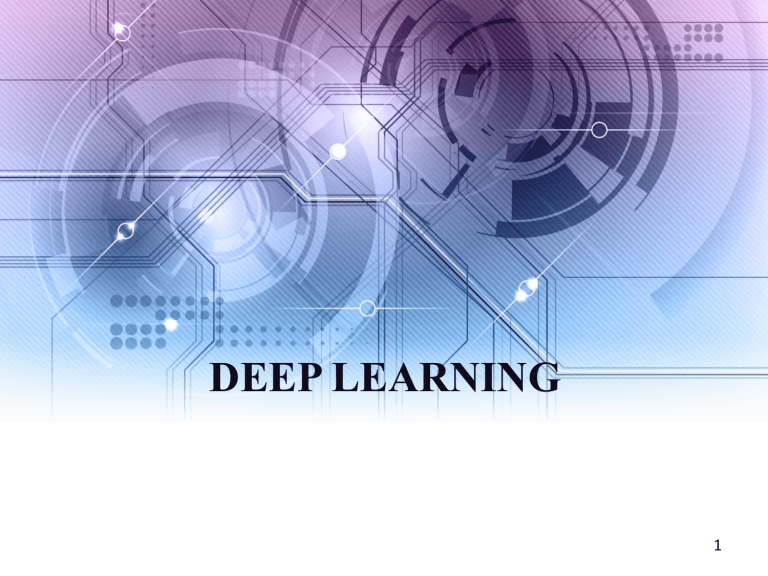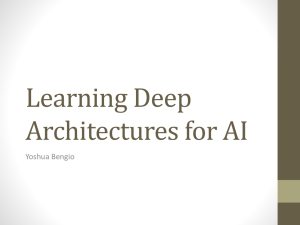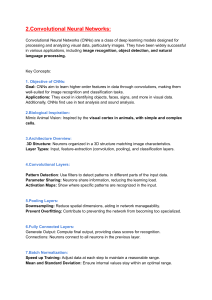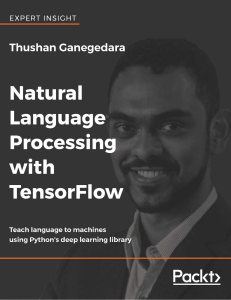
DEEP LEARNING 1 CONTENTS I. II. III. IV. V. VI. VII. VIII. IX. X. XI. XII. Introduction History Principle Technology Working Formulations Advantage Disadvantage Real Time Applications Future Scope Conclusion References 2 INTRODUCTION What is Deep Learning? Deep learning is a branch of machine learning that uses data, loads and loads of data, to teach computers how to do things only humans were capable of before. For example, how do machines solve the problems of perception? 3 HISTORY 1958: Frank Rosenblatt creates the perceptron, an algorithm for pattern recognition. 1989: Scientists were able to create algorithms that used deep neural networks. 2000's: The term “deep learning” begins to gain popularity after a paper by Geoffrey Hinton. 2012: Artificial pattern-recognition algorithms achieve humanlevel performance on certain tasks. 4 PRINCIPLE Deep learning is based on the concept of artificial neural networks, or computational systems that mimic the way the human brain functions. 5 TECHNOLOGY Deep learning is a fast-growing field, and new architectures, variants appear every few weeks. We'll see discuss the major three: 1. Convolution Neural Network (CNN) CNNs exploit spatially-local correlation by enforcing a local connectivity pattern between neurons of adjacent layers. 6 TECHNOLOGY 2. Recurrent Neural Network (RNN) RNNs are called recurrent because they perform the same task for every element of a sequence, with the output being depended on the previous computations. Or RNNs have a “memory” which captures information about what has been calculated so far. 7 TECHNOLOGY 3. Long-Short Term Memory LSTM can learn "Very Deep Learning" tasks that require memories of events that happened thousands or even millions of discrete time steps ago.LSTM works even when there are long delays, and it can handle signals that have a mix of low and high frequency components. 8 WORKING Consider the following handwritten sequence: Most people effortlessly recognize those digits as 504192. That ease is deceptive. The difficulty of visual pattern recognition becomes apparent if you attempt to write a computer program to recognize digits like those above. 9 WORKING 10 WORKING The idea of neural network is to develop a system which can learn from these large training examples. Each neuron assigns a weighting to its input — how correct or incorrect it is relative to the task being performed. The final output is then determined by the total of those weightings A training Sample A very basic approach: Binary Classifier 11 FORMULATIONS The basis of deep learning is classification which can be further used for detection, ranking, regression, etc. 12 ADVANTAGES 1. It does feature extraction, no need for engineering features 2. Moving towards raw features 3. Better optimization 4. A new level of noise robustness 5. Multi-task and transfer learning 6. Better Architectures 13 CHALLENGES 1. 2. 3. 4. 5. Need a large dataset Because you need a large dataset, training time is usually significant. The scale of a net's weights is important for performance. When the features are of the same type this is not a problem. However, when the features are heterogeneous, it is. Parameters are hard to interpret--although there is progress being made. Hyperparamter tuning is non-trivial. 14 REAL TIME APPLICATIONS 1. Automatic Colorization of Black and White Images 2. Automatically Adding Sounds To Silent Movies 3. Automatic Machine Translation 4. Object Classification and Detection in Photographs 5. Automatic Handwriting Generation 15 REAL TIME APPLICATIONS 6. Automatic Text Generation 7. Automatic Image Caption Generation 8. Automatic Game Playing 16 FUTURE SCOPE 1. Deep Learning will speed search for extra terrestrial life. RobERt, short for Robotic Exoplanet Recognition for Exoplanets that are beyond our solar system. 17 FUTURE SCOPE 2. For Astronauts, Next Steps on Journey to Space Will Be Virtual 3. Droughts and Deep Learning: Measuring Water Where It’s Scarce 18 CONCLUSION The low maturity of Deep Learning and its applications such as large deep neural networks achieve the best results on speech recognition, visual object recognition and several language related task field warrants extensive future research. Nevertheless, the possibilities of deep learning in future are infinite ranging from driverless cars, to robots exploring the universe and to what not if the upcoming architectures are creative enough. 19 REFERENCES [1] Yoshua Bengio(2009), "Learning Deep Architectures for AI", Foundations and Trends in Machine Learning: Vol. 2: No. 1, pp 1-127 [2] Hinton, G. E., Osindero, S., & Teh, YW. (2006). A fast learning algorithm for deep belief nets. [3] Goodfellow, I. J., Warde Farley, D., Mirza, M., Courville, A., & Bengio, Y. (2013). Maxout Networks. [4] Agostinelli, F., Hoffman, M., Sadowski, P., & Baldi, P. (2015). Learning activation functions to improve deep neural networks. [5] Hinton, G. E., Srivastava, N., Krizhevsky, A., Sutskever, I., & Salakhutdinov, R. R. (2012). Improving neural networks by preventing co-adaptation of feature detectors. 20







